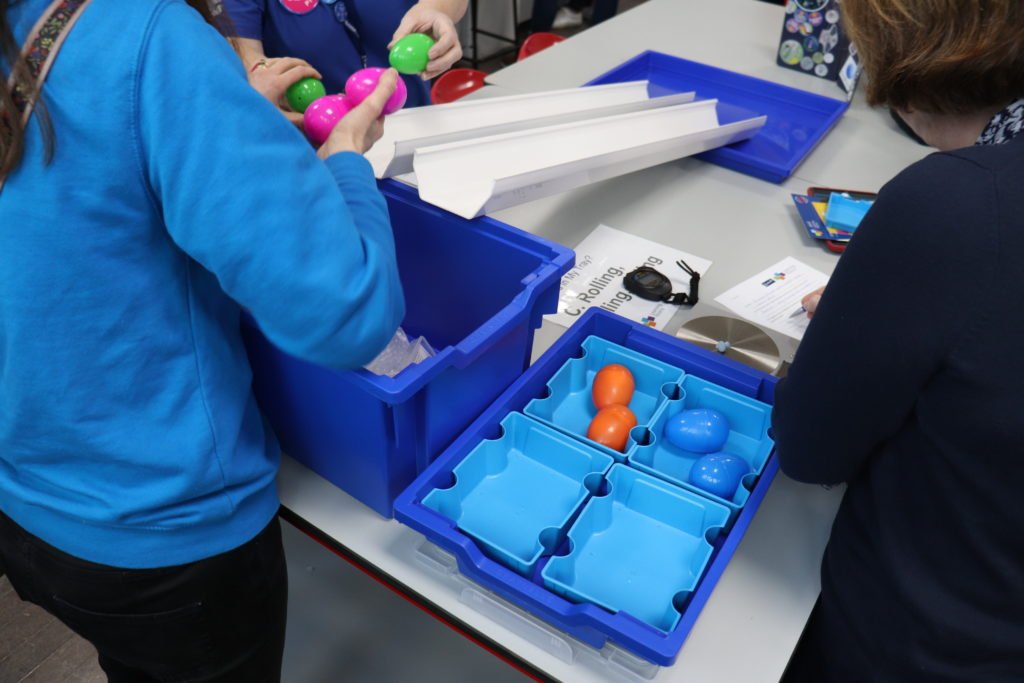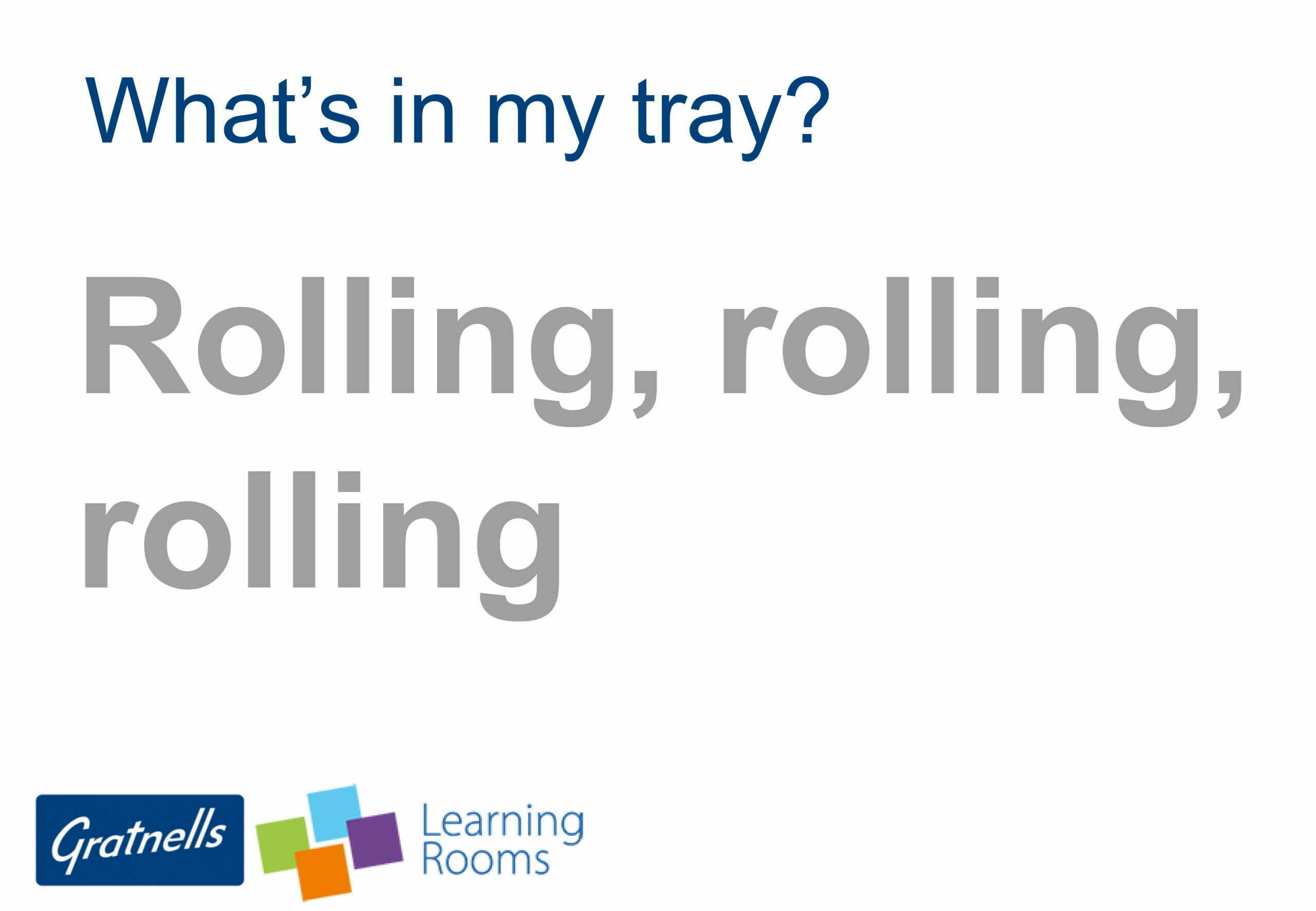Rolling, rolling, rolling
This activity was created as part of a Gratnells What’s in my tray? CPD workshop for primary science teachers to support practical work and delivery of the curriculum. It can be carried out as a stand-alone activity for students or combined with other activities from the session to form a STEM carousel. If you would like to find out more about running this activity as part of a carousel, take a look at the CPD Workshops section of the Gratnells Learning Room website where you will find further details and example carousels.

Investigate forces and friction using a simple comparative test. Perfect for an Easter-themed physics experiment.
Learning outcomes
You will be able to:
- Explain that unsupported objects fall (roll in this case) towards the earth because of the force of gravity.
- Identify the effect of friction on moving objects, describing it as a force which opposes the motion of moving objects.
- Describe what is happening in terms of balanced and unbalanced forces and relate speed to energy.
You will need (per group of 4):
- 1 x Extra deep Gratnells (F25) tray
- 1 x Shallow Gratnells tray with lid
- 1 x Gratnells art tray
- 1 x 4 section Gratnells tray insert or 4 x Blue SortED trays
- 2 x Identical pieces of square guttering 1m long*
- 6 x Small marble sized pieces of blue tack
- 8 x Fillable plastic eggs in four different colours
- 1 x Stopwatch (optional)
- 1 x Electronic weighing scale (optional)
- 1 x Length of bubble wrap 7cm wide by 1.2m long
- An assortment of four different Easter themed (theme is optional) items to fill the eggs sufficient to create matching pairs. We used 6-10 fluffy chicks, 2 Cadburys Crème Eggs or alternate egg of similar size and weight, 16 foil wrapped mini eggs.
- 1 x Instruction sheet
- 1 x Answer sheet
- Paper and pencil, mini white board and pen, or a tablet with camera for recording your answers.
*Tip: If you don’t have spare bits of square guttering available, the channels can be made out of folded lengths of cardboard, just make sure your two channels are identical to make it a fair test.
This activity also works for individuals or smaller groups, just increase the amount of time allocated to complete it. Once prepared, this activity can be repeated multiple times, reusing the same equipment for each group.
Preparation:
- Print and laminate (optional) one copy of the activity instructions or view on any device.
- Print one copy of the activity question sheet or view and edit on any device.
- Set up the guttering channels in parallel to run from the extra deep tray into the art tray. Prevent slippage by placing blue tack strips at the contact points.
- Put the bubble wrap, stopwatch and balance into the extra deep tray.
- Organise all other equipment into the 4-section tray insert or blue SortEDs in the shallow tray and put the lid on.
What to do:
- Lift the lid off the shallow tray and explore the equipment provided.
- Fill each pair of coloured eggs with the following items and close securely:
– Orange eggs – three chicks each
– Green eggs – one chocolate egg each
– Pink eggs – eight foil wrapped mini eggs each
– Blue eggs – empty
- Take it in turns to hold a pink egg at the top of either channel and release it.
- What happened to the egg? Write your answer down.
- Why? Write your answer down.
- Cover the bottom surface of one of the channels with bubble wrap. Tip: Use blue tack and fold the bubble wrap under each end of the channel to secure it in place.
- Hold one pink egg at the top of one guttering channel and one pink egg at the top of the second guttering channel.
- Make a prediction – what will happen when you release the eggs? Write down your prediction.
- Release the eggs simultaneously. Observe what happens and repeat this test 3 times.
- What happened? Write your answer down.
- Why? Write your answer down.
- Why must each pair of eggs be filled with exactly the same number and type of items?
- Suggest two other investigations or expansions to the activity you could carry out with the equipment provided
Tidy up time:
- Empty the eggs back into the 4-section tray insert and replace the lid.
- Remove the bubble wrap and blue tack you added and put it back in the extra deep tray.
- Leave the channels set up in parallel.
- Replace the instructions and leave everything tidy.
When all participants/teams have completed the activity, swap answers with another group and mark the answers as the activity leader reads them out or hand your answers in the activity leader for marking.
Example blank answer sheet
Answers
Q1. What happened to the pink egg?
A1. It rolled down the slope, hit the back of the shallow tray at the bottom and eventually came to a stop.
Q2. Why?
A2. Gravity. The force of gravity acts on the egg causing it to roll down the slope. The egg stops at the bottom where the surface is flat and the forces acting upon it are in balance again.
Q3. What happened?
A3. The egg on the smooth slope is faster / wins the race. The egg on the smooth slope gets to the bottom first. The egg on the bubble wrap slope loses / rolls more slowly than the egg on the other slope.
Q4. Why?
A4. Friction causes the egg on the bubble wrap slope to roll more slowly. There is less friction on the smooth slope so the egg can roll faster.
Q5. Why must each pair of eggs be filled with exactly the same number and type of items?
A5. So the eggs weigh the same. To ensure a fair test when racing the eggs against each other on the different surfaces.
Q6. Suggest two other investigations or expansions to the activity you could carry out with the equipment provided.
A6. Run races between heavier and lighter eggs (make simple comparative observations or use the weighing scales and stopwatch to increase challenge). Or, use the stopwatch to record the time it takes for identical eggs to travel down the bubble wrap slope and the smooth slope and compare the results. Or, anything else sensible and feasible with the equipment available.
2 points for each question. 12 points available in total.
What is happening?
Key words: Gravity, Friction, Speed, Conker.
The equipment set up allows the following ideas in physics to be explored with the students:
- The faster an object is moving, the more energy it possess.
- The effects of balanced and unbalanced forces on the motion of an object.
- The different types of forces which act on an object and how we can influence those forces by altering the equipment set up e.g. changing the surface or angle of the slope.
- That forces have strength and direction.
Gravity is the force that ‘pushes’ everything to the ground. Gravity acts on the eggs and ‘pushes’ them down from the top of the channel to the bottom when released. The equipment can be used to create channels with different surfaces for the eggs to be tested on. The rougher and bumpier the channel surface, the more friction will be generated and the slower the egg will roll (lower speed or velocity), the smoother the channel surface, the less friction will be generated and the faster the egg will roll (higher speed or velocity). The equipment could also be used to investigate the effect of egg weight on the speed of travel. The heavier the egg, the greater the effect of gravity and the faster the egg will roll (higher speed or velocity) and vice versa.
What is speed? Speed = Distance ÷ Time and can be calculated from your readings if you know the length of your channel including the distance to the back wall of the shallow tray.
What is velocity? Velocity is simply speed with a direction. The force of gravity acts on the eggs travelling down the guttering to create velocity. The velocity generated by the egg as it rolls down the slope provides the momentum required to carry the egg over the flat surface of the tray until it hits the back wall of the shallow tray and stops. Momentum doubles as velocity doubles.
Other things to try…
- How could you further decrease the speed of objects travelling down the slope? Try altering slope angle, slope surface, object shape, surface shape be sure to only change one variable at a time.
- How could you increase the speed of the objects travelling down the slope?
- Experiment by using different objects and investigate the effect of streamlining, introducing the concept of air resistance.
- Go large with 4-meter lengths of guttering and take your investigation outside. Experiment with natural objects on the slopes. Remember to consider all the variables, will your results be affected if it is a windy day and how will you ensure a fair test? See our conker rolling activity if you enjoy working outside.
- Get stop ends for your guttering, fill them with water and explore water resistance by racing boats of different designs down the channels. See our duck race activity if you like this idea.
- Research Galileo Galilei and Isaac Newton to find out more about their experiments and how they helped develop the theory of gravitation.
- Share your photographs and videos on social media using #WhatsInMyTray.
Health & Safety
As with all Gratnells Learning Rooms What’s in my tray? activities, you should carry out your own risk assessment prior to undertaking any of the activities or demonstrations. In particular, risks from collisions should be considered.


